Abstract
In order to better serve the users of wood desks in open-plan offices, the Kano model is used to analyze the problems encountered by users in the office. Combined with quality function deployment (QFD), this study conducted an analysis of the weighted average of users’ needs and the importance of engineering measures of product technical characteristics. The proposed system uses an integrated Kano–QFD model to identify users’ specific needs and scene experience with a more complete service system. Through the hybrid approach of the Kano model and QFD development and design technology, the wood desks in open-plan offices are optimized to improve the rationality and scientific nature of office furniture and enhance its market competitiveness.
1. Introduction
With the rapid development of national economies and changes in work, the standard of office furniture is gradually improving. In the field of wood furniture design, including office furniture, sustainable and green practices in design are drawing more concern than ever [1]. The personality and preference of users are also the important starting point for the design and research of office furniture such as office chairs, in addition to satisfying functional and physiological needs [2]. Kwon found that the parameters of office layouts and desk locations were the significant predictor factors for the probability of satisfaction variables [3]. The open-plan office design has received more attention in current research and practice. Its popularity as a workplace design has increased substantially [4,5]. In order to better serve users’ office needs in open-plan offices, a more complete service system that meets the users’ specific requirements and scene experience is needed with a design method driven directly by users’ office application demands.
At present, research on office space furniture focuses on green practices in planning and designing to improve the efficiency and comfort of office furniture. Matthew recommended that such planning remains a key item for the improvement of office capabilities so as to facilitate upgrading office furniture through green practices in planning and related correspondence with clients [1]. In the shared workspace, Viola offered an inventive furniture system with soundproof panels that leverages smart materials to fulfill users’ needs for acoustic comfort [6]. Research also focuses on translating customer needs into designing essential factors to satisfy them. Andreja argued that such an approach cultivates experience regarding appropriate configurations as indicated by shopper inclinations and perspectives, constituting a significant factor in the production of wooden furnishings [7]. Masaji evaluated individuals’ shopping conduct regarding wooden furniture to determine clients’ utilization goals for feasible furnishings [8]. Choodoung offered a systematic examination of the design process, design assessment, and design-dependent elements of wooden furniture based on user experience and used the dining armchair as a case study [9]. Ye researched the development of modular children’s furniture using scene theory to better clarify the interaction between products, users, and their requirements [10]. Wang employed the analytical hierarchy process (AHP) to prioritize the functional order of the office furniture’s features, such as height adjustment, sedentary reminders, and lighting adjustments [11]. Lastly, research focuses on the analysis and exposition of the necessity and trends of furniture design in office space. Didem considered it critical for science and technology to make advances in this field in order to accommodate the evolving requirements and diverse expectations of the new generation of flexible office furniture. Open office furniture is designed with lightness, mobility, deformability, acoustics, and adaptability to new technology in mind [12]. Managing space, communicating, collaborating, and sharing would be the primary goals of the future office, according to Fan, who stated that the varied development of society has broken down the isolation of office furniture and raised the importance of user experience [13]. According to the actual needs of users, the dynamic and static dimensions, and many unique use scenarios, Liu investigated and optimized the design of office chairs [14]. However, the literature lacks relevant reports on effective approaches to wood desk designs for open-plan offices. The Kano model and quality function deployment (QFD) technology has been used in manufacturing and the service industry. This paper explored a hybrid integration approach combining two models for wood desk designs for open-plan offices. The Kano model was created by Noriaki Kano, a Japanese quality management expert, and was developed as a means to determine users’ demand attributes. QFD is a customer-oriented tool that provides the path for translating customer voice or needs into product specification [15]. Quality function deployment (QFD) was first introduced into Japanese manufacturing enterprises; later, QFD technology was commonly adopted by enterprises in Europe and the United States. QFD is a powerful tool for translating customer requirements into technical specifications, and it is frequently used in the design of products and services [16]. QFD was first introduced by Akao in 1972 at Mitsubishi’s Kobe shipyard site, and then Toyota and its suppliers developed it further for a rust prevention study [17]. After the concept of QFD was introduced in the US through auto manufacturers and parts suppliers [18], many US firms, such as AT&T, Digital Equipment, Ford, GM, Hewlett-Packard, Procter & Gamble, and Raychem, applied QFD to improve product development and communication [19,20].
Qualitative research using the Kano model has been combined with quantitative research using the QFD model to gradually form a mature integrated model. For instance, Tontini utilized the Kano-QFD integrated model to devise a case plan arrangement to further develop the client experience of draft beer mugs [21]. Similarly, Avikal et al. examined the SUV profile with the Kano model and QFD hypothetical technique, and they identified the tasteful qualities of SUV cycling appearance best meeting clients’ interests and assessments [22], while Kuo et al. researched consumer requests regarding food wellbeing credits through the Kano model and QFD technique, with reference to ventures to actually dispense assets and form item improvement systems [23].
In this study, the Kano–QFD integrated model is applied to the design of wood desks for users. This analysis using the Kano model allows us to determine the relationship between office demand and satisfaction of various product factors. We do this by establishing a relation matrix between needs and design criteria obtained from users and determining users’ design preference using the quality function deployment (QFD) approach. We start with the fundamental needs of users, from which we develop innovative ideas for wood desk design against the background of the open-plan office mode.
2. Materials and Methods
2.1. Research Technical Route
This study of the wood desk design for an open-plan office based on the Kano–QFD integration model seeks to determine and analyze the group characteristics of users more accurately through the investigation of open-plan office wood desk users, as well as determine whether personas help make design solutions that better meet real user needs.
First, we established initial contact with users to understand the investigated group’s situation and confirmed their real needs. Next, we conducted a comprehensive analysis of the demand factors of open-plan office wood desk users, obtained the comprehensive score of wood desk users, determined the needs of wood desk users, and summarized the design requirements and objectives required in the design process of wood desk design. Lastly, we established the key requirements of QFD of quality output in the design, and a wood desk for open-plan offices was planned and designed according to the ranked values of the key requirements of the design.
In this paper, the Kano model is used to classify the demand indicators of office furniture users, and then the QFD method (quality function deployment) is used to transform the users’ demands into the rules in the process of office furniture R&D. The QFD method can accurately identify the user’s design requirements and control the design process. The Kano–QFD model is constructed to double check the consumer demand indicators, which can make the design of office furniture closer to the real needs of consumers.
2.2. Kano Model
Kano developed his model to define a product or service’s quality on the basis of how well it satisfies customers’ or users’ needs. In Kano’s model, users’ needs are categorized into five groups: Attractive/Excitement Quality (A), One-dimensional/Performance Quality (O), Must-be/Basic Quality (M), Indifferent Quality (I) and Reverse Quality (R) [24]. In addition, there is a Question Option (Q), which usually does not appear unless the question of Kano questionnaire itself is wrong or the user understands it incorrectly (Table 1). Basic attributes are the minimum required features that customers naturally expect from a product or service for fulfilling the basic functions of a product; when they are not present, customers will be entirely dissatisfied [25,26]. Performance attributes produce both satisfaction and dissatisfaction depending on performance levels, and satisfaction is proportional to the level of fulfillment of these attributes. In a nutshell, if these attributes are not designed, customers will be unhappy, while full satisfaction of these requirements would result in customer satisfaction [27]. Excitement attributes are key factors for customer satisfaction, which can be described as surprise and delight attributes that produce satisfaction when delivered but cause no dissatisfaction if not delivered [28] (Figure 1). Indifferent attributes refer to aspects that are neither good nor bad, and they do not result in either customer satisfaction or customer dissatisfaction. Reverse attributes refer to a high degree of achievement resulting in dissatisfaction and to the fact that not all customers are alike.

Table 1.
Kano model requirements: qualitative table.
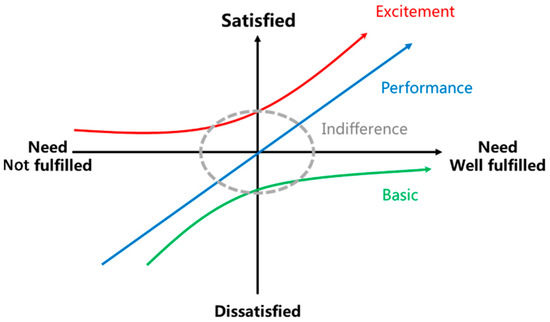
Figure 1.
Kano two-dimensional quality model.
2.3. Quality Function Deployment (QFD)
QFD utilizes the house of quality (HOQ), which is a matrix providing a conceptual map for the design process, as a construct for understanding customer needs and establishing priorities of technical requirements to satisfy them [29]. Figure 2 presents a schematic diagram of the house of quality (HOQ) of QFD, which consists of the left wall, ceiling, roof, room, floor, right wall, and other aspects. Six major steps are required to complete this matrix: the determination of the (1) customer needs (“WHATs”), (2) planning matrix, (3) technical requirements (“HOWs”), (4) inter-relationship matrix between WHATs and HOWs, (5) technical correlation matrix for the roof, and (6) technical matrix for targets.
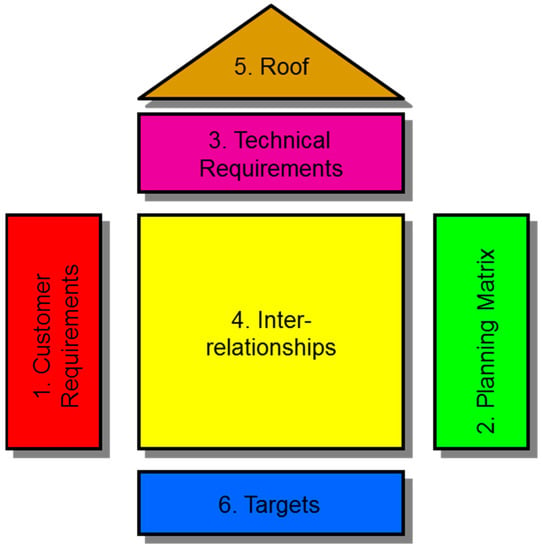
Figure 2.
Framework of a typical QFD matrix.
2.4. User Survey
A user survey is conducted with user interviews and questionnaires. The user interviews elicit data for a more in-depth understanding of users, and the questionnaire is the most common form of user survey.
For this study, data were collected from a survey of 260 wood desk users objectively according to the actual use and preferences of wood desk users in open-plan offices. The survey objects were mainly those engaged in office work in enterprises and institutions in Chengdu, Southwest China. The collected information included respondents’ gender, age, occupation, level of education, income, office environment, office efficiency, satisfaction with office furniture, and the comfort of office furniture. The main collected information was as follows: 118 males, accounting for 45.38%, and 142 females, accounting for 54.62%; 96 people aged 20–30, accounting for 36.92%, 59 people aged 31–40, accounting for 22.69%, 69 people aged 41–50, accounting for 26.54%, and 36 people aged over 50, accounting for 13.85%; 259 people with high-school education or above, accounting for 99.62%, in which, 46 obtained high-school education, accounting for 17.69%, 158 obtained college degrees, accounting for 60.77%, and 55 obtained master’s degree or above, accounting for 21.15%. After completing the closed questionnaire survey, an open questionnaire survey and case study were conducted. Examination of the survey data identified 36 demand factors of wood desk users [30,31].
The integrated approach using Kano’s model and QFD involves a series of activities from classifying user demand elements to evaluating the priority of technical characteristics. The previous steps can serve as the baseline reference for each step. To simplify the space, each user’s demand element is denoted “A”. All 36 user demand elements are classified into three groups: functional, emotional, and technological requirements, as shown in Table 2.

Table 2.
Definitions of wood desk user demand elements.
2.5. Integration Approach of Kano’s Model and QFD
This study proposes an extensive technique consolidating the Kano model and QFD to obtain the plan components of open office furniture. The incorporated strategy includes a progression of exercises from the grouping of client credits to the investigation of the needs for the prerequisites and plan components. Past advances can act as a gauge for the following stage, and the means for assessing plan components are displayed in the figure beneath (Figure 3).
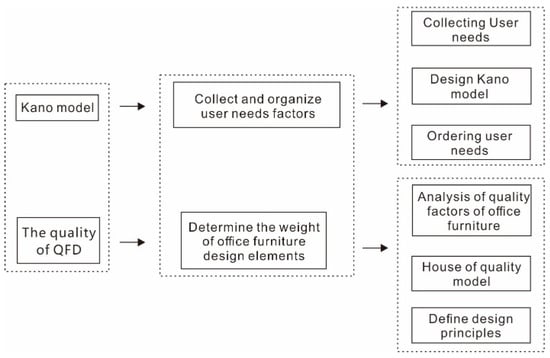
Figure 3.
Kano–QFD model application process.
The calculation of the comprehensive user importance evaluation index (Zi) of the Kano model involves a comprehensive statistical analysis of multiple data. The Kano model classification table lists the user demand importance index (Hi), user satisfaction increasing index (SII), user dissatisfaction decreasing index (DDI), and user satisfaction ideal improvement index (Vi), where Hi refers to the demand assessment with a score of 1–5 after the KJ summary, which is used to represent the self-rated importance value of the i-th office furniture user. We determine the ratio of excitement qualities (A), performance qualities (O), basic qualities (M), and indifferent qualities (I) among users to that of the i-th user’s needs, denoted Ai, Oi, Mi, and Ii, respectively. The absolute values of the SII and DDI indices can vary from 0 to 1. In the formula for DDI, a negative value signifies customer dissatisfaction, and satisfaction increases as the value increases from 0 to 1. The specific values of the user satisfaction index (Ti) are calculated from the SII and DDI indices. In order for Ti to serve as effective reference data, the K value is taken to adjust the demand. The values of K of 0, 0.5, 1, and 1.5 can be interpreted as indicating indifferent, basic, performance, and excitement quality, respectively.
The satisfaction and final satisfaction of multiple interviewees are divided by the average satisfaction value of this demand. The ideal improvement index of users’ satisfaction (Vi) is obtained as the quotient of the final satisfaction index (S1) and satisfaction index (S0). On the basis of the above data, the comprehensive evaluation value of demand importance (Zi) is finally obtained as important input data for the QFD house of quality.
The matrix correlation (Rij) between technical performance importance and design requirements is analyzed and calculated. The importance index (Wj) of the design requirements is obtained by integrating the Zi, and the design requirements are sorted according to the importance indices. Finally, a wood desk design for an open-plan office based on the Kano-QFD integration model is obtained.
3. Results
The user interview and closed questionnaire data were analyzed to determine the user demand index; 36 user demand elements were identified, and the collected questionnaires were classified and evaluated accordingly (Figure 4). The KJ method was applied to organize the user needs hierarchically, allowing the indicators to be quantitatively evaluated. The user needs were divided into functional demand (A1-type indicators), emotional demand (A2-type indicators), and technological demand (A3-type indicators). A Kano demand degree survey was conducted on three demand groups, and the demand category table of the target demand degree was obtained (Table 3). The importance score of users’ demand for wood desk ranged from 1 to 5 points, where a higher score indicates higher urgency. The score (Hi) is the average score of users’ demand for wood desks. The evaluation of the respondents’ satisfaction with a particular demand and overall happiness with the survey procedure is known as the ideal improvement rate of user satisfaction (Vi), whose value falls in the range 1–9; the resultant value has an immediate impact on the design specifications and practice system (Table 4).
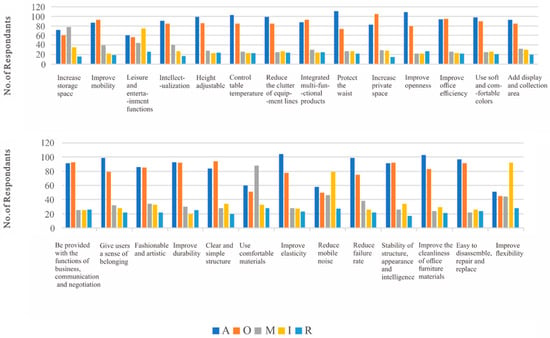
Figure 4.
Kano–QFD model application process.

Table 3.
Kano model classification table of wood desks.

Table 4.
User demand importance score table (Hi).
User satisfaction is measured by the user satisfaction increasing index (SII) and user dissatisfaction decreasing index (DDI), as shown in Table 5. These SII and DDI indices of the Kano model can describe those requirements that really bring differentiation to the wood desk design in an open-plan office, as well as identify those requirements that users view unfavorably. This paper also makes use of the adjusted improvement ratio k, which can take the values 0, 0.5, 1, and 1.5, and the corresponding four requirements of indifferent qualities (I), basic qualities (M), performance qualities (O), and excitement qualities (A). This approach has proved very useful in identifying user demands more conveniently and can help to enhance the level of customer satisfaction by indicating appropriate modifications. The user satisfaction increasing index (SII) and user dissatisfaction decreasing index (DDI) were statistically analyzed and plotted along the coordinate axes (Figure 5). SII was plotted on the portion of the Y-axis ranging between 0 and 1, while DDI was plotted on the X-axis between 0 and 1. We divided the axes at the values of 0.5 to obtain four quadrants: the first (red), second (yellow), third (green), and fourth (purple), corresponding to A, B, C, and D.

Table 5.
Table of user satisfaction values and adjustment values.
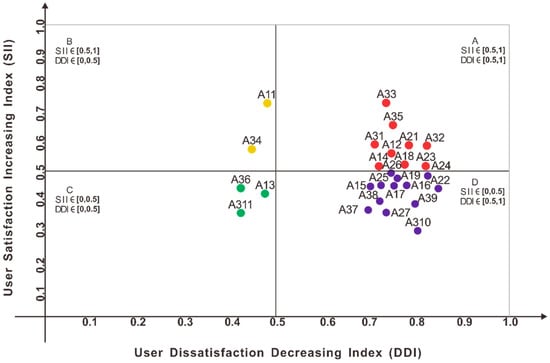
Figure 5.
User satisfaction numerical coordinate distribution map.
District A in the main quadrant is the locale of unitary quality components, relating to A33, A35, A31, A21, A32, A12, A14, A18, A23, A24, and A26 in the figure. Both better and worse absolute values of these quality variables are relatively high. On the off chance that this kind of necessity is indicated, user fulfillment will be enhanced; any other change will result in its reduction. Accordingly, this sort of necessity ought to be fulfilled first. A11 and A34 are in the second quadrant, B, which is the area filled by essential necessities. Such requirements cannot be neglected, yet users are impartial in addressing their necessities. The better value of these requirements is higher, while their worse value is lower. The third quadrant area C belongs to irrelevant requirements, corresponding to the three requirements (A13, A36, and A311) in the figure. In the investigation of item plan, such prerequisites will not straightforwardly affect client fulfillment. Region D, the fourth quadrant, contains excitation-type interest, relating in the figure to A25, A19, A22, A15, A16, A38, A17, A39, A37, A27, and A310, and these interest credits can unequivocally enhance user acknowledgment, while inability to meet such interest will not reduce user fulfillment (Figure 5).
The user satisfaction ideal improvement index directly affects the priority of a certain demand factor of wood desks. The comprehensive evaluation index (Zi) of users’ demand degree of wood desk is derived from the values of SII, DDI, Kano classification results, and Vi and Hi from the comprehensive calculation. The comprehensive evaluation index of users’ demand for features of office furniture was calculated as shown in Figure 6. The final value Zi of Kano model was input into the QFD house of quality to identify important design points, as shown in Table 6.
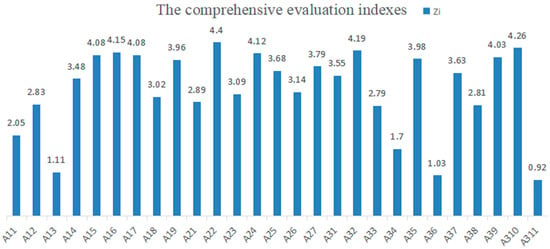
Figure 6.
Demand degree comprehensive evaluation results.

Table 6.
Hierarchy of design requirements.
According to the hierarchy of Kano model user needs, three categories such as functional design are listed item by item, and more than 20 subcategory design requirements such as storage space are added. There is a certain relationship among the subcategories in each category, but they are independent of other design requirements, as shown in Table 6. In order to make the design point of wood desk of users more reasonable in terms of planning, combining the QFD method and user demand hierarchy table, the specific implementation requirements of various design levels were deduced. Next, a relationship matrix was established between the user demand level and the design requirement level. The correlations were classified as strong, medium, and weak. The software package QFDv3.3 was used for the correlation analysis, and the three correlation levels were represented by symbols ●, █, and ▲. The Wij of design requirements was output according to the user demand comprehensive score, user demand matrix, and other data, as shown in Figure 7. Design practice and design planning for wood desks for open-plan offices can be conducted in accordance with the importance values of design requirements.
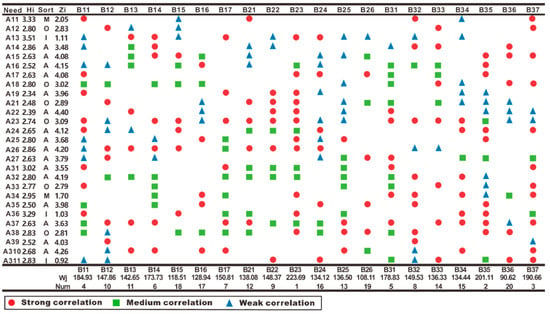
Figure 7.
QFD house of quality design importance.
4. Discussion
According to the Kano–QFD integration model, the importance value can be determined. The first six items are sorted by their Wi values: B23 office efficiency improvement design (Wi = 223.69) > B35 low failure rate design (Wi = 201.11) > B37 flexible design (Wi = 190.66) > B11 storage space design (Wi = 184.93) > B31 material artistic design (Wi = 178.83) > B14 multifunctional intelligent office design (Wi = 173.73) (Figure 8). As Tuncel and Hande stated, the development of information technology has led to office work being performed in new ways [12]. Modern office furniture design pushes two concepts to an extreme: communication and efficiency. With the development of information systems, the emergence of the Internet, and the spread of e-mail, office workers have actually become “free movers”, and office furniture design has begun to consider issues such as wiring, power, and portability. The use of electronic devices has increased, and the sharing of information has become widespread. As a consequence, priorities and needs have changed toward flexible furniture systems that support alternative uses of space [12,13]. The integrated model analysis led to a final design aim that actually prioritizes efficiency, complexity, and versatility. Designers should treat data models dialectically when designing wood desks for open-plan offices so as to aim for clerical office furniture designs that promote high user satisfaction. Similarly, Rolfö discovered through interviews with employees in some organizations that had switched to activity-based flexible offices that employees’ perceived performance and satisfaction with their actual work had indeed improved, and a conceptual model of design implementation was proposed [32]. Big data have also been gradually applied to the field of office design. By tracking the utilization rate of office space and office furniture, it is possible to improve the effective utilization of office space and afford employees a better office experience. In order to analyze office furniture using anthropometric data from sitting positions, Amira examined postural deficits from an anthropological perspective, along with a consideration of ergonomic factors [33]. In a study of the impact of digitization on office furniture, Simecomi likewise proposed an arrangement of customizable and astutely planned workbenches [34]. Intelligent office furniture that incorporates technologies such as the Internet of things, sensors, and smart chips affords unlimited possibilities for meeting human needs in all directions. Compared with traditional office furniture, smart office furniture has established more relationships with people, which has enriched and complicated the interactive experience process between users and products.
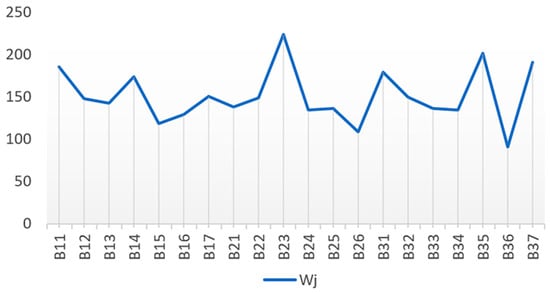
Figure 8.
Sorting result of quality design importance.
5. Conclusions
In this paper, a Kano–QFD integrated model was used to study and analyze the form design, storage space, leisure, and entertainment factors of wood desks through a qualitative analysis of the needs of user groups and ranking of the needs of users. In order to reduce subjective bias, QFD theory was used to quantify the weight of various factors. The hierarchy of open office furniture functions was then established, taking into account other crucial work functions such as high efficiency improvement, low failure rate design, flexible change, and intelligent diversification. As a scientific model for qualitative and quantitative research on user needs, the Kano–QFD integrated model can facilitate the development and design of wood desks for the open-plan office, providing data to support the product development stage. Technological innovation provides the hardware foundation for the development of designs for all office furniture. In the future, user experience will play an increasingly important role in the design of office furniture. With this approach and advances in production, information, and computer technologies, more adaptable and ergonomic furniture can be created. The new generation of office furniture has improved methodical designs. The integrated model allows us to predict that the primary goals of office furniture design will be space management, flexibility, sustainability, intelligence, and sharing. Virtually, this research conclusion will also be important in deciding the design strategy of other public space design, other furniture systems, and other utility products.
Author Contributions
Conceptualization, J.L., L.Y. and M.C.; methodology, J.L., R.C. and M.C.; writing—original draft preparation, R.C. and J.W.; writing—review and editing, J.L. and M.C. visualization, R.C. and J.W.; supervision, J.L. and M.C.; project administration, M.C.; funding acquisition, M.C. All authors have read and agreed to the published version of the manuscript.
Funding
This research was funded by the Ministry of Education Humanities and Social Sciences Research Project of China (Grant No. 19YJC760009), the Key Research and Development Project of Sichuan Science and Technology Plan Projects (Grant No. 2020YFS0357), and the Double Support Plan of Sichuan Agricultural University (Grant No. 2022SYZD06).
Data Availability Statement
Not applicable.
Conflicts of Interest
The authors declare no conflict of interest.
References
- Bumgardner, M.S.; Nicholls, D.L. Sustainable Practices in Furniture Design: A Literature Study on Customization, Biomimicry, Competitiveness, and Product Communication. Forests 2020, 11, 1277. [Google Scholar] [CrossRef]
- Ko, Y.-C.; Lo, C.-H.; Chen, C.-C. Influence of Personality Traits on Consumer Preferences: The Case of Office Chair Selection by Attractiveness. Sustainability 2018, 10, 4183. [Google Scholar] [CrossRef]
- Kwon, M.; Remøy, H. Office employee satisfaction: The influence of design factors on psychological user satisfaction. Facilities 2020, 38, 1–19. [Google Scholar] [CrossRef]
- Maher, A.; Hippel, C.V. Individual differences in employee reactions to open-plan offices. J. Environ. Psychol. 2005, 25, 219–229. [Google Scholar] [CrossRef]
- Kim, J.; Dear, R.D. Workspace satisfaction: The privacy-communication trade-off in open-plan offices. J. Environ. Psychol. 2013, 36, 18–26. [Google Scholar] [CrossRef]
- Geniola, V.; Camplone, S.; Marano, A.; Rossi, E. Design of an innovative furniture system: Improving acoustic comfort in coworking workplaces. In Proceedings of the International Conference on Intelligent Human Systems Integration, Modena, Italy, 19–21 February 2020; Springer: Cham, Switzerland, 2020; pp. 835–841. [Google Scholar] [CrossRef]
- Pirc Barčić, A.; Kitek Kuzman, M.; Vergot, T.; Grošelj, P. Monitoring Consumer Purchasing Behavior for Wood Furniture before and during the COVID-19 Pandemic. Forests 2021, 12, 873. [Google Scholar] [CrossRef]
- Sakagami, M.; Sakaguchi, D. Estimating Preferences for Wood Furniture in Terms of Sustainable Forest Management. Forests 2022, 13, 687. [Google Scholar] [CrossRef]
- Choodoung, S.; Smutkupt, U. Factors of successful wooden furniture design process. Int. J. Ind. Manuf. Eng. 2012, 6, 2117–2121. [Google Scholar] [CrossRef]
- Ye, J.; Li, W.; Yang, C. Research on Modular Design of Children’s Furniture Based on Scene Theory. In Proceedings of the International Conference on Human-Computer Interaction, Yokohama, Japan, 8–13 May 2021; Springer: Cham, Switzerland, 2021; pp. 153–172. [Google Scholar] [CrossRef]
- Chunpeng, W.; Qing, X. Analysis of functions of healthy office furniture based on analytic hierarchy process. In Proceedings of the E3S Web of Conferences, Nanjing, China, 11–13 September 2020; Volume 179, p. 02070. [Google Scholar] [CrossRef]
- Tuncel, D.B.; Kayan, H.Z. The design of flexible furniture for the new generation offices. Civ. Eng. Archit. 2018, 6, 78–87. [Google Scholar] [CrossRef]
- Fan, Y.; Jin, Y. Research on the Development and Future Trend of Office Furniture Design. In Proceedings of the E3S Web of Conferences, Nanjing, China, 11–13 September 2020; Volume 179, p. 02075. [Google Scholar] [CrossRef]
- Jinghui, L. Design of Office Seats for Meeting Room Environment and Visitors Area Based on Ergonomics. In Proceedings of the E3S Web of Conferences, Nanjing, China, 11–13 September 2020; Volume 179, p. 01009. [Google Scholar] [CrossRef]
- He, L.; Song, W.; Wu, Z.; Xu, Z.; Zheng, M.; Ming, X. Quantification and integration of an improved Kano model into QFD based on multi-population adaptive genetic algorithm. Comput. Ind. Eng. 2017, 114, 183–194. [Google Scholar] [CrossRef]
- Pawitra, T.A.; Tan, K.C. Tourist satisfaction in Singapore—A perspective from Indonesian tourists. Manag. Serv. Qual. Int. J. 2003, 13, 399–411. [Google Scholar] [CrossRef]
- Wasserman, G.S. On how to prioritize design requirements during the QFD planning process. IIE Trans. 1993, 25, 59–65. [Google Scholar] [CrossRef]
- Sullivan, L.P. Quality function development. Qual. Prog. 1986, 19, 39–50. [Google Scholar]
- Ansari, A.; Modaress, B. Quality function development: The role of suppliers. Int. J. Purch. Mater. Manag. 1994, 30, 27–35. [Google Scholar] [CrossRef]
- Griffin, A. Evaluating QFD’s use in US firms as a process for developing products. J. Prod. Innov. Manag. 1992, 9, 171–187. [Google Scholar] [CrossRef]
- Tontini, G. Integrating the Kano Model and QFD for Designing New Products. Total Qual. Manag. Bus. Excell. 2007, 18, 599–612. [Google Scholar] [CrossRef]
- Avikal, S.; Singh, R.; Rashmi, R. QFD and Fuzzy Kano model based approach for classification of aesthetic attributes of SUV car profile. J. Intell. Manuf. 2020, 31, 271–284. [Google Scholar] [CrossRef]
- Kuo, C.; Yuo, S.; Lu, C.Y. Integration of the Kano and QFD model in health food development: Using black beans as examples. Qual. Quant. 2014, 48, 225–242. [Google Scholar] [CrossRef]
- Baki, B.; Sahin Basfirinci, C.; Murat AR, I.; Cilingir, Z. An application of integrating SERVQUAL and Kano’s model into QFD for logistics services. Asia Pac. J. Mark. Logist. 2009, 21, 106–126. [Google Scholar] [CrossRef]
- Matzler, K.; Sauerwein, E. The factor structure of customer satisfaction: An empirical test of the importance grid and the penalty-reward-contrast analysis. Int. J. Serv. Ind. Manag. 2002, 13, 314–332. [Google Scholar] [CrossRef]
- Matzler, K.; Hinterhuber, H.H.; Bailom, F.; Sauerwein, E. How to delight your customers. J. Prod. Brand Manag. 1996, 5, 6–18. [Google Scholar] [CrossRef]
- Tan, K.C.; Pawitra, T.A. Integrating SERVQUAL and Kano’s model into QFD for service excellence development. Manag. Serv. Qual. Int. J. 2001, 11, 418–430. [Google Scholar] [CrossRef]
- Löfgren, M.; Witell, L. Kano’s theory of attractive quality and packaging. Qual. Manag. J. 2005, 12, 7–20. [Google Scholar] [CrossRef]
- Park, T.; Kim, K.J. Determination of an optimal set of design requirements using house of quality. J. Oper. Manag. 1998, 16, 569–581. [Google Scholar] [CrossRef]
- Bansak, K.; Hainmueller, J.; Hopkins, D.J.; Yamamoto, T. The number of choice tasks and survey satisficing in conjoint experiments. Political Anal. 2008, 26, 112–119. [Google Scholar] [CrossRef]
- Weng, J.; Di, X.; Wang, C.; Wang, J.; Mao, L. A Bus Service Evaluation Method from Passenger’s Perspective Based on Satisfaction Surveys: A Case Study of Beijing, China. Sustainability 2018, 10, 2723. [Google Scholar] [CrossRef]
- Rolfö, L.V. Relocation to an activity-based flexible office–Design processes and outcomes. Appl. Ergon. 2018, 73, 141–150. [Google Scholar] [CrossRef]
- Almaz, H.; Fawzy, A. The impact of anthropometrics on the functional design of office furniture. Int. Des. J. 2022, 12, 21–30. [Google Scholar] [CrossRef]
- Simek, M.; Fictum, L. Consequences of digitalisation on office furniture design. In Digitalisation and Circular Economy: Forestry and Forestry Based Industry Implications, Proceedings of 12th Woodema Annual International Scientific Conference, Varna, Bulgaria, 11–13 September 2019; Chobanova, R., Ed.; Union of Scientists of Bulgaria: Sofia, Bulgaria, 2019. [Google Scholar]
Publisher’s Note: MDPI stays neutral with regard to jurisdictional claims in published maps and institutional affiliations. |
© 2022 by the authors. Licensee MDPI, Basel, Switzerland. This article is an open access article distributed under the terms and conditions of the Creative Commons Attribution (CC BY) license (https://creativecommons.org/licenses/by/4.0/).